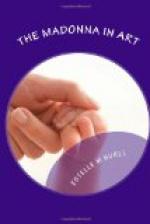In the Venetian school, Titian and Tintoretto both painted the subject of the Madonna in glory, but the pictures are not notable compared with many others from their hands.
From the North of Italy we naturally turn next to the South, to inquire what Raphael was doing at the same period in Rome. Occupied by many great works under the papal patronage, he still found time for his favorite subject of the Madonna, painting some pictures in the styles already mastered, and two for the first time in the style of the Madonna in the sky.
[Illustration: SPANISH SCHOOL.—MADONNA ON THE CRESCENT MOON.]
The first was the Foligno Madonna, now in the Vatican Gallery. It was painted in 1511 for the pope’s secretary, Sigismund Conti, as a thank-offering for having escaped the danger of a falling meteor at Foligno. No thoughtful observer can be slow to recognize the superiority of this composition over all others of its kind in point of unity. Here is no formal row of saints, each absorbed in his or her own reflections, apart from any common purpose. On the contrary, all unite in paying honor to the Queen of Heaven. Not less superior to his contemporaries was the painter’s skill in arranging the figures of Mother and child with such grace of equilibrium that they seem to float in the upper air.
In the Sistine Madonna, Raphael carried this form of composition to the highest perfection. So simple and apparently unstudied is its beauty, that we do not realize the masterliness of its art. We seem to be standing before an altar, or, better still, before an open window, from which the curtains have been drawn aside, allowing us to look directly into the heaven of heavens. A cloud of cherub faces fills the air, from the midst of which, and advancing towards us, is the Virgin with her child. The downward force of gravity is perfectly counterbalanced by the vital energy of her progress forward. There is here no uncomfortable sense, on the part of the spectator, that natural law is disregarded. While the seated Madonna in glory seems often in danger of falling to earth, this full-length figure in motion avoids any such solidity of effect.
The figures on either side are also so posed as to arouse no surprise at their presence. We should have said beforehand that heavy pontifical robes would be absurdly incongruous in such a composition, but Raphael solves the problem so simply that few would suspect the difficulties. The final touch of beauty is added in the cherub heads below, recalling the naive charm of the similar figures in the Umbrian picture we have considered.
[Illustration: BOUGUEREAU.—MADONNA OF THE ANGELS.]
After the time of Raphael, a pretty form of Madonna in glory was occasionally painted, showing the Virgin with her babe sitting above the crescent moon. The conception appears more than once in the paintings of Albert Duerer, and later, artists of all schools adopted it. Sassoferrato’s picture in the Vatican Gallery is a popular example. Tintoretto’s, in Berlin, is not so well known. In the Dresden Gallery is a work, by an unknown Spanish painter of the seventeenth century, differing from the others in that the Virgin is standing, as in the oft-repeated Spanish pictures of the Immaculate Conception.




